Magritte, magician of the absurd
Magritte is, along with Dali, the surrealist artist who has played the most with images… and with us. He is a master creating unknowns with his brushes.
As a good surrealist, the Belgian painter played to disconcert to sow in the viewer the doubt of reality in his images. Unlike the French surrealists, who took it very seriously, Magritte opted for irony.
His winks or repeated games are of various kinds. He sometimes changes the size of things, making them bigger or smaller. Other times he fragments objects or figures into various pieces, as a puzzle, dehumanises, invents, misplaces … in a word, he intrigues us with each of his canvases.
“I have found a new possibility that things have, that of gradually becoming something else, an object merges into another object other than itself. By this means I obtain paintings in which the gaze ‘must think’ in a completely different way than usual.”
Size games
Like Alice in Wonderland (by Lewis Carrol), the universe Magritte invented is full of objects that become gigantic or landscapes and figures that become tiny.
Thus he offers us an imaginary toast with a transparent and crystalline glass placed on a bucolic landscape next to a small river. As if this contrast was not disconcerting enough, the glass is empty but a great cloud of immaculate white rests on it, like a crown.
The effect of changing the scales of things is one of the constant mental tricks in his work and has been called Megalomania.
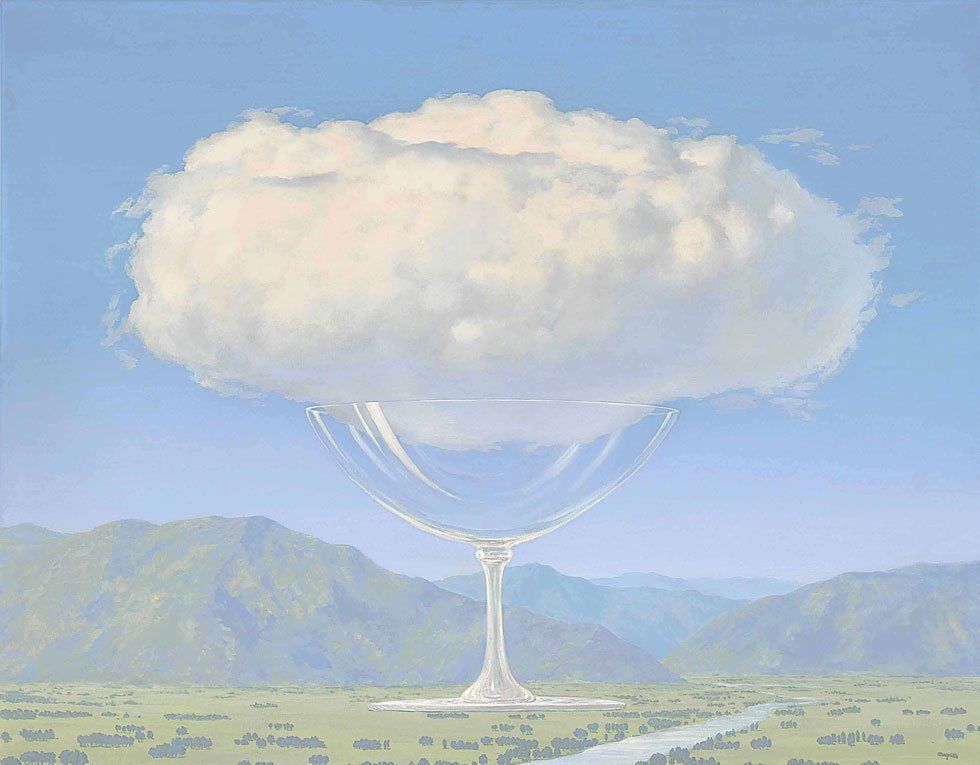
Fragmentation games
Looking at some of Magritte‘s nudes, I can’t help but remember the Russian Matrushka dolls, where each one opens into two parts to discover a smaller one inside it and so on.
The artist painted several pictures, such as Delusions of grandeur where he presents us a female torso, without head, arms, or legs. If this already means that it is defragmented, he goes further, cutting it into two or three parts and progressively decreasing their size, to make each one fit within the previous one.
The fact that his women appear, almost always as headless figures, may be reminiscent of the death of his mother.
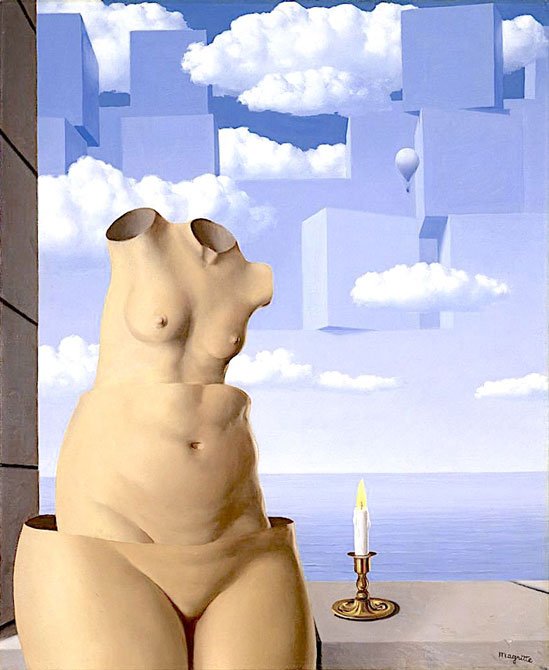
Finally, in these strange nudes, he is not satisfied with defragmenting the main figure but he also does it with the sky. The backgrounds are of immense originality as he transforms the sky into interlaced cubic squares, as if playing between clouds.
Just these skies, they could have been the main theme for all an artist’s work (as in the case of the Dutch painter Escher), but in this case, they are simply a backdrop to the main motif.
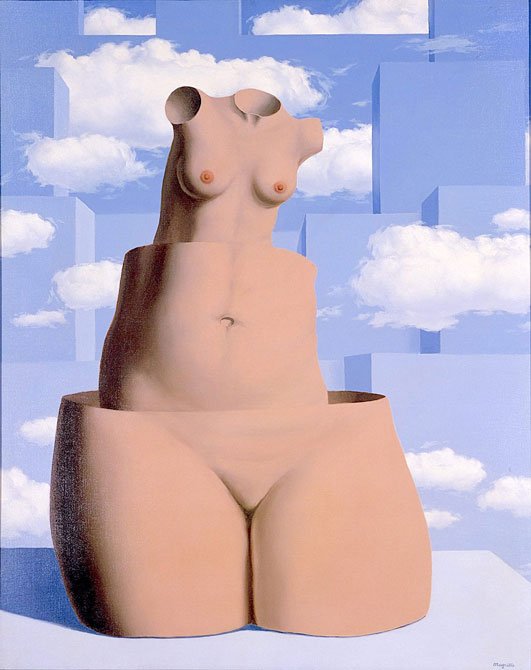
Deshumanization games
Another of his techniques to transform reality into something more dreamlike and magical is dehumanizing his figures. This is the case of the nude portrait of a woman, half human, half sculpture.
This time, he does paint her head, arms and legs, but she is only human from the legs to the waist. From there her skin gradually transforms into a stony gray, until it becomes a stony head, like an expressionless sculpture that recalls the portraits of the noble patricians in the Roman Empire.
To give contrast to this impassive, almost dead face, he counters her with a white dove, much more alive than she looks, perched on her shoulder. A new game comparing stillness and movement, femininity and animal life.
The woman, standing in front of a sea with pink tones, rests her hands on a huge gray stone that reinforces the stony sensation of her own figure.
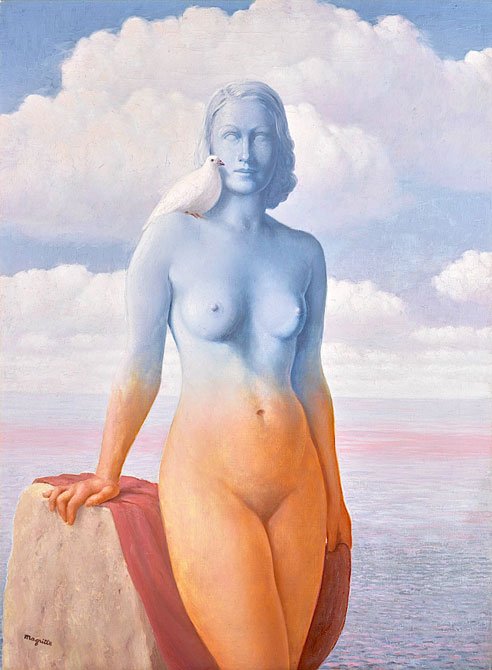
Invention games
As a good inventor, Magritte creates objects and figures that only exist in his mind. One of the most interesting, appears in its different versions of Sheherezade.
They are a kind of faces, formed by what look like pearls joined in the air, where there are only three solid shapes: the eyes and the mouth. Through the set pearls, we can see the background of the scene. In one case it is a beach with a completely calm sea behind and an enigmatic ball on the sand.
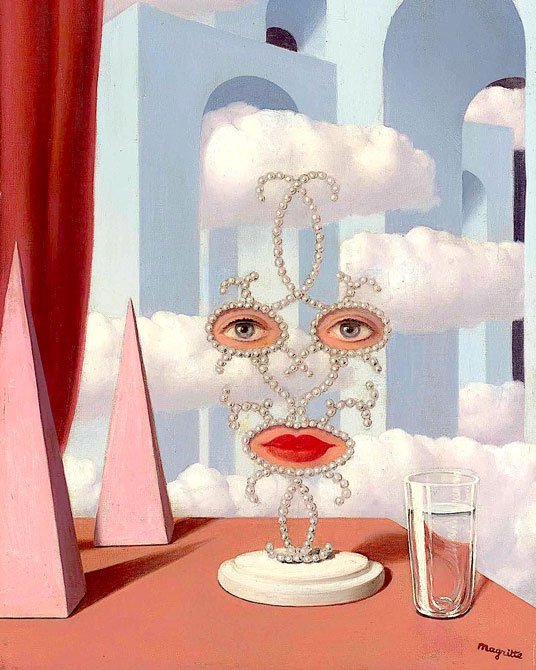
In another painting, the strange face lets us see behind a sky with cubic shapes, on a kind of table turned into a stage. An open curtain reveals two large obelisk-shaped cones and a glass of water. Once again, the artist plays with sizes, since obelisks are usually gigantic and here he presents them together with an object as small as it is banal: a crystal glass.
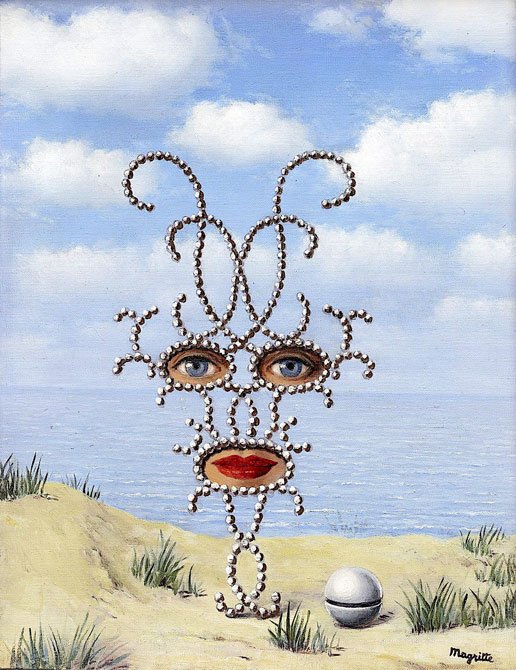
Dislocation games
Another of Magritte‘s optical or rather mental tricks is to place misplaced objects in places where they don’t make any sense.
It is the example of the door that he places on the sandy beach, as if entering a calm sea. But it is a meaningless door because there is no house, it is just a door in the air.
If this non-existent architecture is not understood, the cloud that becomes the protagonist is even more enigmatic. He is almost a living being because he seems to be entering (or leaving) through that magical door as if he were the inhabitant of that place without walls or ceiling.
It must be understood that the clouds in Magritte‘s work are almost living beings since they star in many of his paintings and form an extraordinary environment in others.
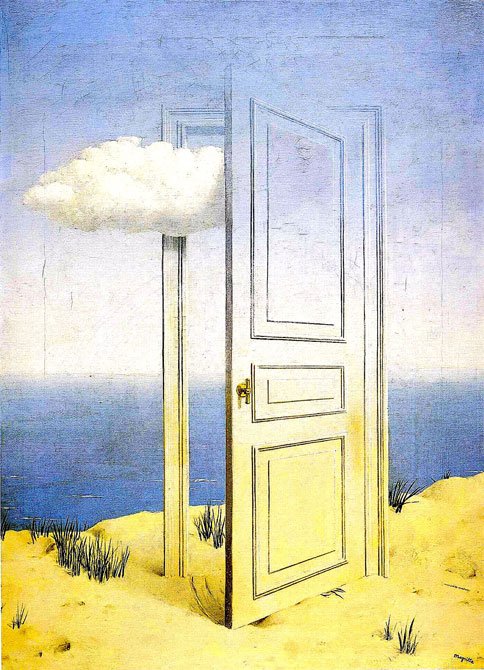
I used to show objects in my paintings located where they are never found. Given my desire to make the most familiar objects howl, they had to be arranged in a new order and acquire a disturbing meaning.
Frame play within frame
The artist also plays with absurd effects between the figure and the background. In some cases, he alternates fragmented images with landscapes.
Thus the equestrian portrait of an amazon in the forest, which appears as camouflaged between trees in an impossible landscape where the trunks of the trees blend in with the amazon’s own image instead of obstructing her vision.
As a curious fact, the artist was part of the Société du Mystère”(Mystery Society) whose members concentrated on investigating everything invisible and unknown.
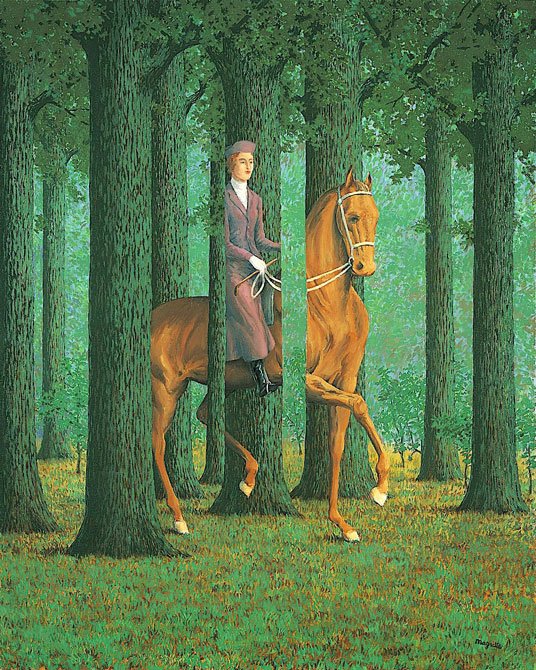
Iconic works such as Ceci n’est pas une pipe (This is not a pipe) with the presence of painted words and their optical games with the figure and the background, have left a unique mark on the collective imagination. Without a doubt, his work is immediately recognisable as his.
Men with bowler hats, nudes, clouds, curtains and apples are some of the most recurrent themes that are repeated without rest in his pictorial career. In addition to his peculiar style, there is something else, purely surreal: although Magritte seems to convey his absurd universe to us, there was method in his madness.
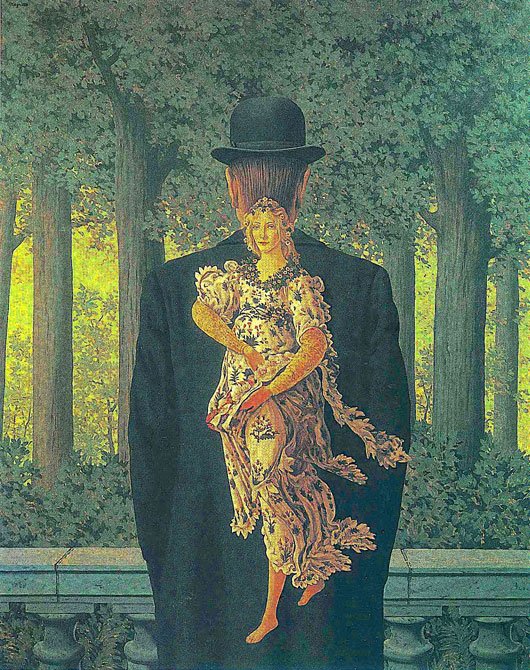
His obsessive themes come back again and again with countless variations. He creates a whole series of traps to show us that images can be contradictory and paradoxical, make us believe one thing and actually represent another.
Few artists have played as much with the viewer as Magritte. For the Belgian artist, the world is an indecipherable unknown. Admiring his enigmatic paintings full of mystery, I would like to baptise him as the magician of the absurd.
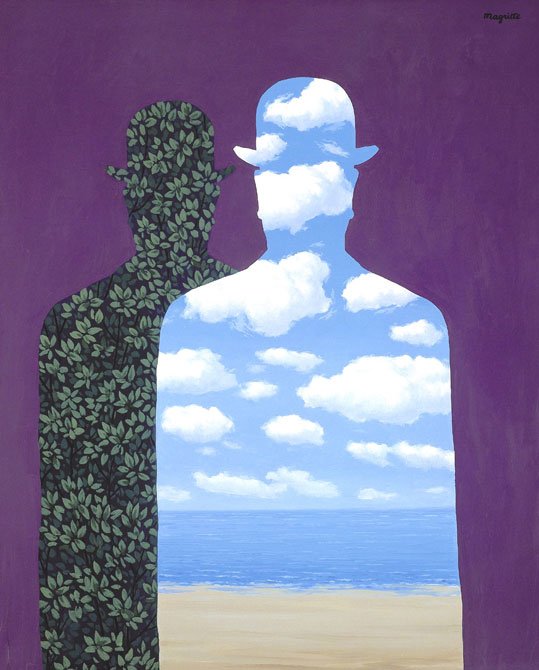
Mental surrealist
Rene Magritte (1898-1967) was one of the two top Belgian surrealist painters, together with Paul Delvaux. Magritte is known for his mind games with images while Delvaux focuses on subconscious sexuality. But Magritte also has a sensual side, perhaps the least known.
His witty and thought-provoking paintings sought to have viewers question their perceptions of reality, and become hypersensitive to the world around them.
Magritte’s mother was a suicidal woman, which led her husband, Magritte’s father, to lock her up in her room. One day, she escaped, and was found down a nearby river dead, having drowned herself.
According to legend, 13 year old Magritte was there when they retrieved the body from the river. As she was pulled from the water, her dress covered her face. This later became a theme in many of Magritte’s paintings in the 1920’s, portraying people with cloth covering their faces.
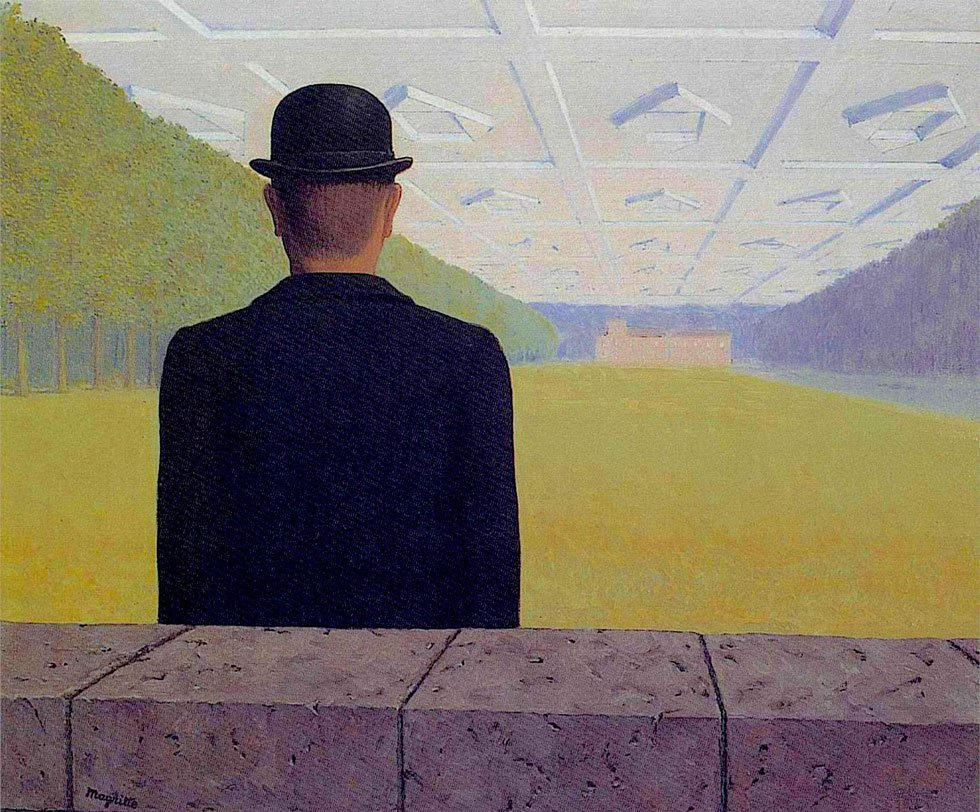
Rene began drawing lessons at age ten. In 1916 he went to study a the Royal Academy of Fine Arts in Brussels, where he found the instruction uninspiring and unsuited to his tastes.
He did not begin his actual painting career until after serving in the Belgian infantry for a short time, and working at a wallpaper company as a draftsman and producing advertising posters. He was able to paint full time due to a short-lived contract with Galerie le Centaure, allowing him to present in his first exhibition, which was poorly received.
Magritte made his living producing advertising posters in a business he ran with his brother, as well as creating forgeries of Picasso, Braque and Chirico paintings.
His experience with forgeries also allowed him to create false bank notes during the German occupation of Belgium in World War II, helping him to survive the lean economic times.
Known for his ingenious and provocative images, the Belgian surrealist painter intended with his work to change the preconditioned perception of reality and force the observer to become hypersensitive to his environment.
Through creating common images and placing them in extreme contexts, Magritte sough to have his viewers question the ability of art to truly represent an object.
In his paintings, he often played with the perception of an image and the fact that the painting of the image could never actually be the object.
The gigantic element in his paintings can be a natural object – a nude, an apple, a rose … – and with a rounded shape, in contrast to the cubic and artificial space in which it is enclosed.
An expert in this resource was the writer Lewis Carroll, much admired by Magritte and recognised by André Breton among the forerunners of surrealism.
The most obvious instance of inspiration drawn from Carroll‘s Alice in Wonderland in Magritte‘s work is the Delusions of Grandeur series of paintings. Their central motif is a female sculptural torso divided into three hollow parts, each one fitted into the next, as in Russian dolls or as a telescope.
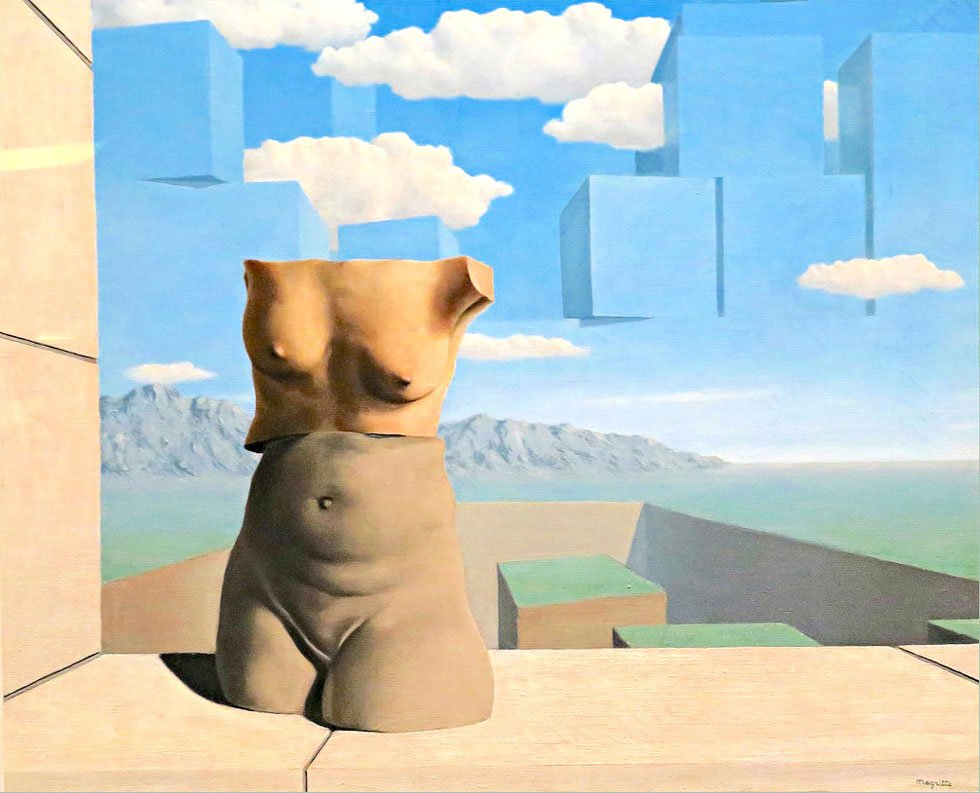
When megalomania takes place on the outside, it takes the form of an ascension. Magnification and levitation produce the same effect of taking the object or character out of its environment and projecting it into a new and neutral one, and they appear more visible than ever.
Like the bells that become gigantic and rise like great globes, planets or extraterrestrial ships, or the men with bowler hats who converse in the air, or the rock, which has become the main motif of several late paintings.
The essence of an object is revealed when we place it in an unusual situation or, better still, in a situation incompatible with its natural tendency.
His artistic interpretations influenced many modern artists, including Andy Warhol, Jasper John and Jan Verdoodt. His art, which was especially popular during the 1960’s, has also influenced numerous songs, movies and books.
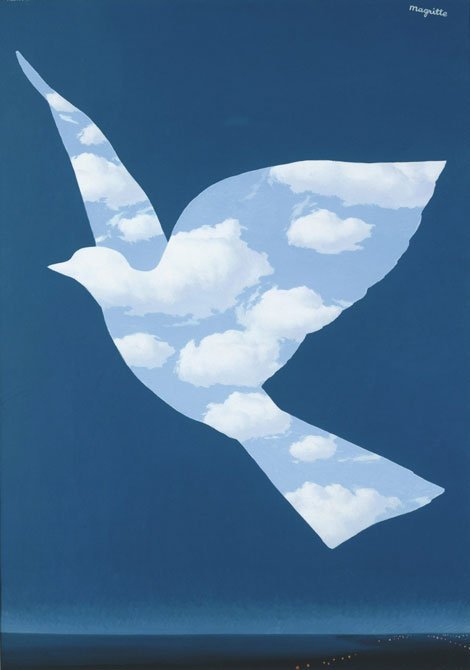
The Thyssen-Bornemisza Museum hosts the first retrospective in Madrid of the surrealist painter from which the Juan March Foundation dedicated him in 1989.
Curated by Guillermo Solana, former Culture Minister and artistic director of the museum , the exhibition will bring together around 70 works, including paintings and works on paper, along with a selection of photographs and films.
Ever since the ideal of mechanising creative work was born, the painter René Magritte also fantasised about a catalog of gadgets conceived to automate processes of thought and creation, among which was a universal machine for making pictures. Now the Museo Nacional Thyssen-Bornemisza will reveal the operation of this imaginary machine in this exhibition.
Exhibition “The Magritte Machine” at Thyssen Museum, Madrid. September 14, 2021 – January 30, 2022

